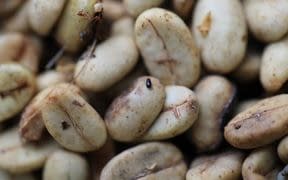Effectsof climate change on coffee Production.
Effects of Climate Change on Coffee Production
Reduced crop yields are a result of drought in some regions and increased humidity and precipitation in others. For example, increase moisture leads to the proliferation of pests like the Coffee Berry Borer and diseases including ‘la rosa’ or stem rust.  Coffee rust hit central American coffee production in 2012-13. As a result, prices for consumers in the U.S. jumped about 33% from 2011 – 2013.
Coffee rust hit central American coffee production in 2012-13. As a result, prices for consumers in the U.S. jumped about 33% from 2011 – 2013.
 Coffee rust hit central American coffee production in 2012-13. As a result, prices for consumers in the U.S. jumped about 33% from 2011 – 2013.
Coffee rust hit central American coffee production in 2012-13. As a result, prices for consumers in the U.S. jumped about 33% from 2011 – 2013.
Coffee production is dependent on predictable cycles of rainfall, dry periods and temperature changes. Coffee typically flowers when there’s a dry period followed by significant rainfall. Generally, a dry period of three months is necessary to stress the coffee plant and produce flowers. However, a shorter dry period and extended rainfall can result in reduced flowers. Fluctuations in weather patterns such as precipitation, temperature, storms, strong winds, and other extreme weather patterns can negatively affect the quality and production level of crops.
In a recent study among Colombian coffee producers, 91% reported changes in the flowering and fruiting cycles of coffee plants. 75% noticed an increase in pests, and 59% reported an increase in crop disease. Margins for farmers are already extremely thin. Even one crop failure can mean the difference between profit and loss.

Comments
Post a Comment